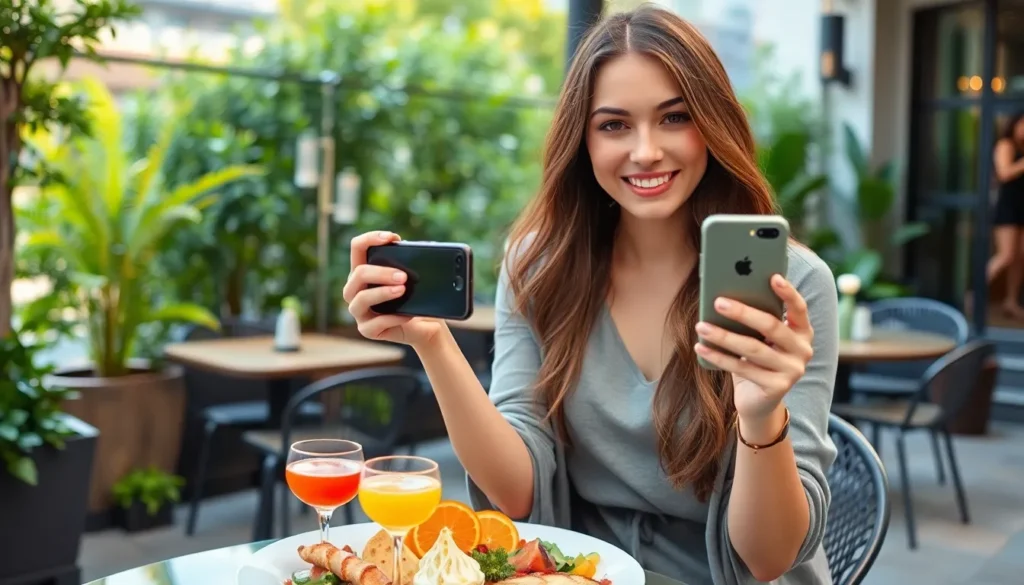In a world where everyone’s vying for attention, social influencer campaigns have emerged as the secret sauce for brands looking to stand out. Picture this: your favorite influencer, sipping coffee and casually promoting a product that suddenly feels like a must-have. It’s not magic; it’s the power of influence at work.
Brands are realizing that partnering with the right social media personalities can turn their marketing strategies from “meh” to “wow!” With a sprinkle of authenticity and a dash of charisma, these campaigns can skyrocket engagement and drive sales like never before. And tools like a profile picture maker can help influencers polish their online presence, ensuring every post and profile stands out. So, if you’re ready to dive into the wild world of social influencers, buckle up! It’s time to explore how these campaigns can transform brands and create buzz that even your grandma would notice.
Table of Contents
ToggleOverview of Social Influencer Campaigns
Social influencer campaigns play a pivotal role in modern marketing strategies. Brands leverage influencer partnerships to engage with target audiences more effectively. Effective collaboration can significantly amplify brand messages and expand reach across various platforms.
Influencers possess a unique ability to foster authentic connections with their followers. Authenticity often translates to trust, making influencer endorsements particularly powerful. Charismatic influencers can create compelling content that resonates with consumers, shaping their perceptions and driving purchasing decisions.
Campaign types vary, encompassing sponsored posts, product reviews, and takeovers. Sponsored posts highlight specific products, while product reviews provide in-depth insights that inform potential buyers. Takeovers offer a fresh perspective, allowing influencers to directly engage with a brand’s audience.
Metrics for measuring success include engagement rates, conversion rates, and audience growth. High engagement rates indicate that content resonates with viewers. Conversion rates reveal how many viewers take desirable actions, such as making a purchase or signing up for newsletters. Audience growth showcases the campaign’s ability to capture new followers and expand brand visibility.
Rising trends in social influencer campaigns indicate a shift towards micro-influencers. Micro-influencers often boast higher engagement rates despite having smaller followings. Campaigns involving micro-influencers frequently achieve greater authenticity, appealing to niche audiences effectively.
Social influencer campaigns blend creativity with strategic marketing objectives. Success hinges on choosing the right influencers and tailoring content to align with target audience preferences. Through collaboration, brands can harness the genuine influence of social media personalities to enhance their visibility and drive results.
Importance of Social Influencer Campaigns
Social influencer campaigns deliver significant benefits for brands aiming to enhance their visibility and connect with audiences.
Building Brand Awareness
Building brand awareness involves utilizing influencers who share similar values with a brand. These partnerships expose brands to wider audiences, generating interest and curiosity. Each post, story, or video from an influencer can reach thousands or even millions of followers, providing a valuable platform for brand visibility. Research shows that 70% of teens trust influencers more than traditional celebrities. Thus, leveraging influencers effectively resonates more with consumers, fostering recognition and recall. Engaging in campaigns further establishes a brand’s identity within specific markets, differentiating it from competitors and driving word-of-mouth.
Engaging Target Audiences
Engaging target audiences becomes seamless when brands collaborate with relatable influencers. Authentic connections formed between influencers and their followers encourage interaction and participation. Campaigns that include user-generated content invite followers to share their experiences, deepening engagement. Studies indicate that 60% of consumers prefer content from influencers over brand content. Content resonating with audiences translates into higher interaction levels and memorable brand experiences. Tailoring campaign messages to align with influencers’ styles captures interest and drives effective communication, ultimately turning engaged consumers into loyal advocates.
Types of Social Influencer Campaigns
Social influencer campaigns encompass various strategies that brands use to engage audiences effectively. These types include sponsored content and product collaborations, each serving specific objectives.
Sponsored Content
Sponsored content involves influencers creating posts featuring brand products or services in a way that feels natural to their followers. Brands choose influencers whose audiences align with their target demographics, enhancing reach and relevance. Influencers incorporate storytelling techniques to present products authentically, making their endorsements more credible. According to research, 70% of consumers favor recommendations from influencers over traditional advertisements. This type of campaign typically includes clear disclosures to maintain transparency. Brands can track engagement metrics, such as likes and shares, measuring the effectiveness of each sponsored post.
Product Collaborations
Product collaborations represent another effective type of influencer campaign that focuses on crafting special products or limited editions. Brands and influencers often co-create items that reflect the influencer’s personal style and resonate with their followers. This unique partnership generates excitement and anticipation among consumers. For instance, the collaboration between a fashion influencer and a clothing brand can lead to exclusive merchandise that fans eagerly seek. Limited-time offerings help drive urgency, encouraging quick purchases. Influencer insights guide brands in designing products that meet audience preferences, ensuring higher satisfaction and loyalty.
Measuring the Success of Social Influencer Campaigns
Measuring the success of social influencer campaigns involves analyzing specific performance metrics. These metrics provide insight into the effectiveness of collaborations and their impact on brands.
Key Performance Indicators (KPIs)
Key performance indicators (KPIs) play a critical role in evaluating campaign success. Engagement rates, representing interactions such as likes, comments, and shares, offer a glimpse into audience responsiveness. Conversion rates track how many followers take desired actions, like making purchases. Audience growth reflects the increase in followers, highlighting brand awareness. Brands often monitor these KPIs to refine strategies and optimize future campaigns. Establishing clear KPIs before launching a campaign ensures focus on measurable outcomes.
Analyzing Engagement and Reach
Analyzing engagement and reach reveals how well campaigns resonate with audiences. Engagement rates indicate the level of interaction with posts, showcasing the influencer’s effectiveness. Reach measures the total number of unique accounts that see the content, providing insight into audience exposure. Tools such as Google Analytics and social media insights can track these metrics accurately. A high engagement rate often correlates with authentic connections that influencers forge with their followers. Brands can use this information to assess which campaigns achieve the highest impact and refine future partnerships.
Challenges in Social Influencer Campaigns
Social influencer campaigns face several challenges that brands must navigate. Understanding these issues is vital for maximizing campaign effectiveness.
Authenticity and Trust Issues
Authenticity remains a crucial factor in influencer campaigns. Many consumers express skepticism towards influencers whose promotions feel insincere. Trust issues can arise when influencers promote products that don’t align with their personal brand or values. Research shows that 60% of consumers prefer content from relatable influencers rather than generic brand messages. Brands should prioritize partnerships with influencers who exhibit genuine enthusiasm for their products. Collaboration with authentic influencers fosters stronger connections, enhancing consumer trust. Addressing these challenges directly impacts campaign success and brand credibility.
Navigating Algorithm Changes
Algorithm changes on social media platforms constantly affect influencer visibility. Brands often find themselves adapting strategies due to shifting algorithms that determine content reach. Influencers may experience fluctuations in engagement metrics, complicating campaign effectiveness. Staying informed about platform updates and trends helps brands in navigating these changes. Regularly analyzing performance metrics allows for quick adjustments in approach. Consideration of varying algorithms supports the need to diversify content types across platforms. Employing multi-channel strategies ensures that influencer partnerships maintain visibility and resonate with audiences consistently.
Social influencer campaigns represent a powerful tool for brands aiming to enhance their visibility and engage with target audiences. By leveraging the unique connections influencers have with their followers, brands can foster authenticity and trust that traditional marketing often struggles to achieve.
The success of these campaigns hinges on selecting the right influencers and crafting messages that resonate with their audiences. As the landscape evolves, staying attuned to trends and metrics will ensure brands maximize their impact. Ultimately, effective collaborations with influencers can lead to increased brand awareness and loyalty, making them an essential component of modern marketing strategies.





